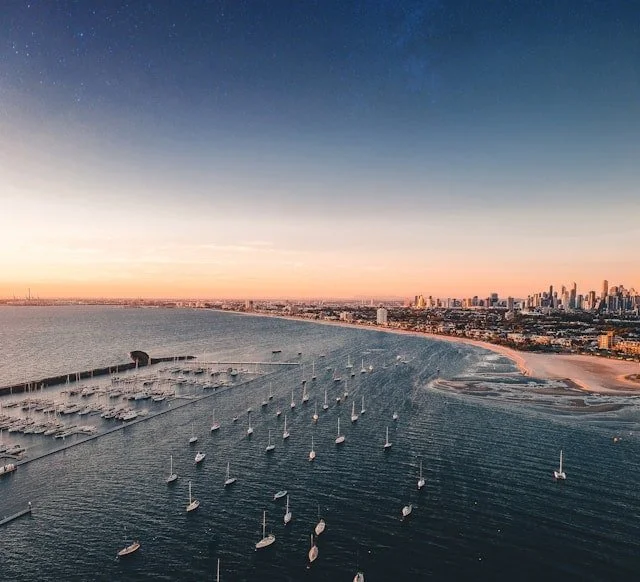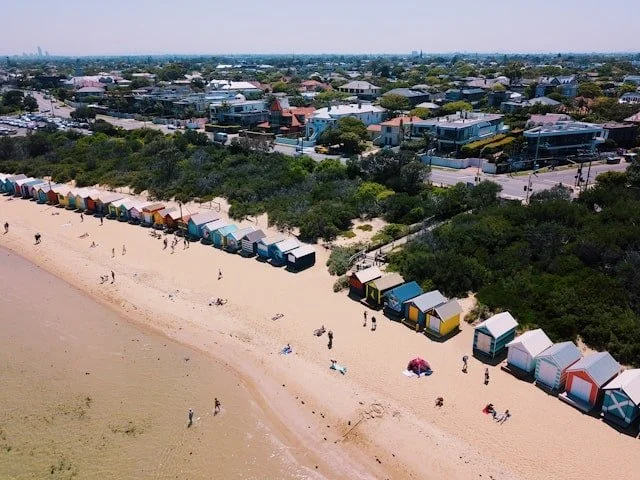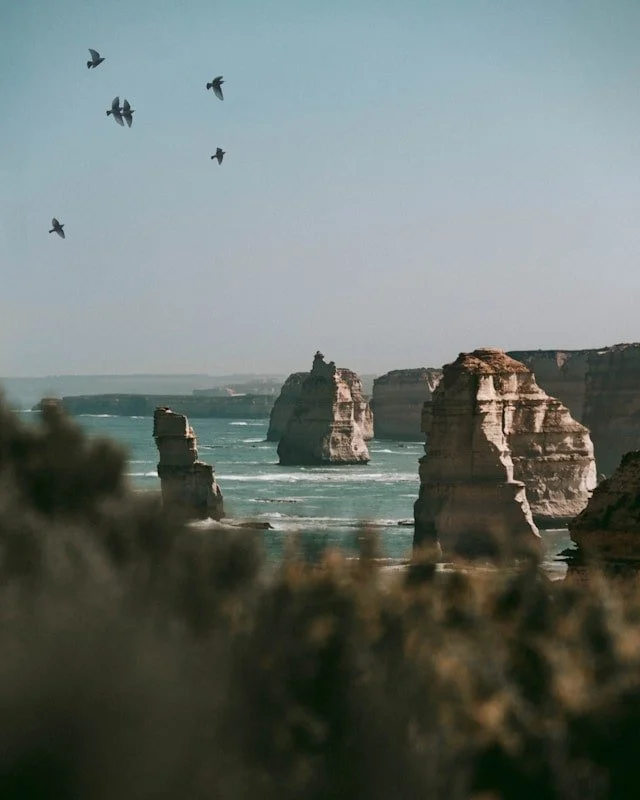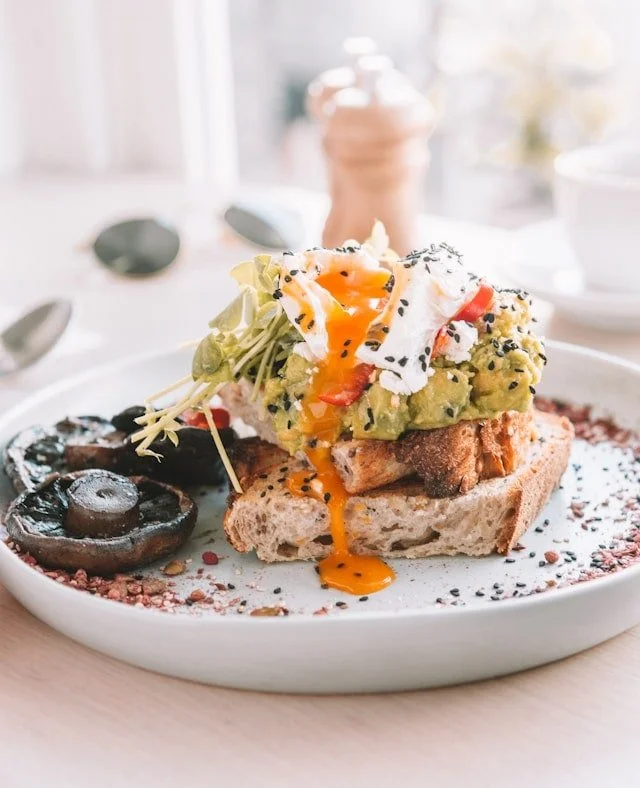Living in Melbourne
Have you ever wondered what living in Melbourne is like? In this local guide, I’m going to break down all the details, from the pros and cons to the cost of living in this part of southeast Australia.
Living in Melbourne promises party-filled weekends, action-packed events and mouth-watering culinary experiences. From the cultural festivities and roaring sports scene to the diversity of day trips dotted around Victoria, living in this city will keep you on your feet.
For the past six years, I’ve been living in Barcelona, and while the land of tapas, fiestas and gob-smacking Gaudi attractions hasn’t gotten old, I’ve deeply craved some change.
So recently, I’ve come back home for a bit. It’s been over half a decade since I lived in Australia, and I’m a little bit shocked by how much things have changed. The prices have skyrocketed, and almost every aspect of this city is somewhat different. Both for good and bad.
For seven years in a row, Melbourne was crowned the most liveable city in the world. But nowadays, that’s no longer the case, and a few factors have come into play.
Don’t get me wrong, living in Melbourne can be a lot of fun, but it’s got a big reputation for being expensive.
Sure, the average salary is a heck of a lot higher compared to the United States or Europe (I used to work for €7 an hour). But when bills, utilities, rent, and groceries add up, you’re sometimes left wondering where that money even went. The cost of living in Melbourne can be… expensive. To say the least.
In this guide, we’re going to dive into the biggest benefits and drawbacks of living here. So if you’re planning to switch things up and shift base to this part of Australia, here’s everything you need to know.
Living in Melbourne, Australia
Known for its laid-back culture, wild nightlife and delectable food scene, Victoria’s capital city paints a dreamy picture. Beyond the surface of street art and style, Melbourne seems to have a lot going for it. Whether you’re interested in the wellness communities, cultural diversity or competitive job opportunities, Melbourne is well worth considering for your move abroad. So let’s get to it.
We’re going to break down everything you need to know about the following:
Neighbourhoods
Transportation
Weather
Education
Healthcare
Safety
Pros and Cons of Living in Melbourne
Average Cost of Living in Melbourne for a Student, Single and Family
11 Best Areas to Live in Melbourne
Melbourne’s neighbourhoods are as multicultural and magnificent as they come. Whether you want to set up base in hipster havens like Fitzroy or channel your inner fashion diva in South Yarra, there’s a suburb that’s suitable for you.
With everything from foodies to nightlife nuts, each part of Melbourne has its own story to tell. Here are some of the best neighbourhoods to live in Melbourne, Australia.
1. CBD (Central Business District)
If it’s your first time visiting Melbourne, spend at least a week getting to know the CBD. Set up base here and enjoy easy access to shops, trendy restaurants and bars. Staying in the CBD will allow you to get to know the public transportation system and will also make it easy to be social and meet people.
Melbourne’s CBD has a great mix of gardens, boutiques and activities. Plus, you can tick all the major attractions off your bucket list. Read a book in the Royal Botanic Gardens, study up a storm in the State Library of Victoria and make new friends in rooftop bars like The Loop and Good Heavens.
2. Fitzroy
Fitzroy is arrayed with art-filled alleyways, hip cafes and vintage stores aplenty. Coined as the ‘alternative’ side of Melbourne, you’ll feel free to express yourself in any way you please. This inner-city neighbourhood has a vibrant arts scene, so it’s great to get inspired by and meet fellow creatives.
Shop at the second-hand book shops, taste vegan food on Brunswick Street and see a live music gig at The Night Cat, Baxter’s Lot or The Old Bar. Connect with Melbourne’s creative locals and find unique crafts at the Rose Street Markets and the Fitzroy Market.
3. St Kilda
Sitting on the cusp of Port Phillip Bay, St Kilda is located about 6 km from the southeast of the CBD. This vibrant district boasts a beachside lifestyle, with swimming and watersports all on offer. The beach scene is matched by buzzing bars and boozy nights out on Acland and Barkly Street.
Wellness enthusiasts and nightlife fanatics collectively coexist in this breezy part of Melbourne.
Start your morning splashing around the St Kilda Sea Baths, see the penguins at the pier and enjoy a sunset stroll along Beaconsfield Parade. Sip happy hour cocktails at The Vineyard and catch live music gigs at the Palais Theatre.
4. South Yarra
Dabble in the finer things in life with high-end living in South Yarra.
This upscale area is well-known for its big-name boutiques, gourmet dining scene and leafy parks. Straddling Melbourne’s Yarra River, the neighbourhood is crowned with art deco apartments, modern high-rises and heritage mansions.
Get social in the elegant cocktail bars and lock lips with some of the best gastronomy the city has to offer. Give your credit card a workout in the ritzy boutiques on popular shopping streets like Toorak Road and Chapel Street.
5. Prahran & Windsor
Situated further down the Chapel Street precinct, Prahran and Windsor are very popular among the international community. Renowned for its nightlife scene, cuisine and sprawling street art, this south-end suburb really gives Fitzroy a run for its money. And in my *biased opinion, it’s way better.
These two neighbourhoods are brimming with bohemian vibes, from the charming markets to the live music events. Indulge in a delectable brunch, sip specialty coffee and dip in and out of the art galleries. Add some extra items to your wardrobe in the vintage shops and oh yeah, and don’t forget to wander around Chapel Street Bazaar.
*Before I moved to Barcelona, I lived in Prahran and Windsor for three years. My time here was unforgettable, and the days were spent somewhere between cafes, pubs and notorious nightclubs like Revolver Upstairs.
6. Brunswick
Brunswick is another one of Melbourne’s hipster havens, but it’s more heavily focused on the arts. This inner-city suburb is dotted with upbeat pubs, al fresco beer gardens and a thriving music scene.
Wander around the art galleries, taste Middle Eastern cuisine on Sydney Road and spend the weekends bar-hopping around town. Feel refreshed in the Brunswick City Baths and get a dose of greenery in Merri Creek.
7. Carlton
Carlton is well-known for its Italian community, with the Lygon Street precinct stealing the spotlight. This place to stay in Melbourne is nestled just north of the CBD and is an ideal neighbourhood for students. Due to its close proximity to universities like the University of Melbourne and RMIT University, this suburb is well-connected with transport.
Get a breath of fresh air in the Carlton Gardens, savour authentic Italian cuisine on Lygon Street and watch a legendary AFL team train at the Carlton Football Club. *This is once again, my biased opinion. I was raised a Carlton football fanatic.
8. Docklands
The Docklands is a bustling area that’s very popular with the expat community in Melbourne. Filled with soaring apartment buildings and office complexes, this place ushers in New York City vibes.
This may not be somewhere that you want to set up for the long term, but it sure is a great spot to ease your way into Melburnian life. Dine on the waterfront, shop at outlets like DFO South Wharf and spend plenty of time in the entertainment venues. This area is home to plenty of public transport options, like trams, trains and buses.
9. Richmond
Although Richmond is perceived as a little rough around the edges, it’s got a lot of charm hidden beneath the surface. This multicultural hub is packed with people from all over the globe, making it a great place to live in Melbourne.
Known for its character-packed historic buildings, you’ll find a fascinating fusion of rooftop bars, music events and classic Aussie pubs. This inner-city neighbourhood is situated just east of the CBD and is also close to the Melbourne Cricket Ground (MCG) and the Melbourne Sports Precinct.
10. Williamstown
Located on the waterfront just west of Melbourne’s CBD, Williamstown is known for its Victorian-era buildings and well-preserved streetscapes. It’s considered a good place to live in Melbourne thanks to its lush parks, open spaces and sprawling restaurant scene.
As Melbourne’s first port settlement, there’s an interesting mix of old and new. Sail on a yacht, swim at the beach or shop ‘til you drop along bustling shopping strips like Douglas Parade, Ferguson Street and Nelson Place.
11. Southbank
Last but not least on this list of the best places to live in Melbourne… Situated on the southern end of the Yarra River, Southbank hones in on fine dining and high-end experiences. Sophistication is key in Southbank, so if that sounds like your jam, definitely add this one to your list.
Spend your evening dining in the al fresco restaurants, soak up the luxury in the Crown Casino Complex and watch awe-inspiring performances in the Arts Centre. Get inspired by the National Gallery of Victoria and book an opera or ballet performance in Hamer Hall.
Housing in Melbourne
Melbourne is home to a huge haul of soaring skyscrapers, heritage buildings and a mix of modern and spacious homes.
Rental prices in each location can vary and depend on a variety of factors. Usually, the cost comes down to the specific location and kind of accommodation you’re after. It’s a good idea to determine your priorities and needs before choosing a place to live in Melbourne. As with most major cities around the world, the inner-city suburbs are generally more expensive. In Melbourne, you can find rental properties through websites like Domain and Realestate.com.au.
When choosing the right place to stay in Melbourne, here are some key questions to consider.
Budget: How much you can afford to spend each month?
Location: How far is it from your workplace, transport, supermarkets, etc?
Type of Property: Do you need a house, unit or apartment?
Rental Duration: How long do you want to stay in the property?
Community: What kind of neighbourhood do you want to live in?
Transportation: Is it close to public transport like buses, trains and trams?
Amenities: Are there schools, supermarkets, parks, restaurants, medical clinics, pharmacies, etc.?
Transportation in Melbourne
Thanks to the city’s extensive public transportation network, getting around Melbourne is a cinch. If you’re located in the inner city and surrounding suburbs, you’ll have access to trains, trams and buses.
Public transport is efficient, clean and runs frequently, making it easy for those who don’t have a car. If you plan on living in Melbourne, you can purchase a Myki Card from train stations, online or some convenience stores.
This reusable smart card is easy to use - simply tap on and off when on public transport. If you’re moving to Melbourne to study, there’s an International Student Travel Pass which covers public transport at an affordable rate.
Another popular option for many Melburnians is cycling. The city is woven with a network of dedicated bike lanes and shared paths. Just keep in mind that helmets are mandatory in Australia.
Weather in Melbourne
Victoria’s capital city is famous for having four seasons in one day. So if there’s anything you should expect here in Melbourne, it’s the unexpected.
Melbourne’s unpredictable weather is a drawback, but it’s not the be-all and end-all. Summer runs from December to February and temperatures often exceed 30°C (86°F). During the warmer months, you can find plenty of fun-packed events and activities.
The winter season runs from June to August and temperatures usually drop to around 10°C (50°F). During this time, many locals go skiing and snowboarding in places like Mount Hotham and Mount Buller.
No matter the season, it’s always best to layer up and carry an extra jacket and an umbrella.
Education in Melbourne
If you’ve considered studying abroad or learning a language overseas, Melbourne could be the best place to do so.
There are around 140 different cultures in Melbourne, making it one of the most diverse cities in Australia. With a wide range of people from all over the globe, Melbourne is regarded as the best place for international students in Australia.
The Victorian capital has several prestigious universities like RMIT University, the University of Melbourne and Monash University. If you want to experience life Down Under, these schools provide a range of courses, including undergraduate, graduate and research programmes.
Healthcare in Melbourne
Living in Melbourne, Australia just gets better and better. Australia is well-known for its healthcare system, which is known as Medicare.
With Medicare, residents have access to free public treatment in public hospitals and clinics. If you live in Australia, you can access the Medicare system if you hold Australian or New Zealand citizenship or have a permanent visa.
If you’re living in Australia on a temporary visa, only some countries are eligible for Medicare. If you’re from a country that has a Reciprocal Health Care Agreement with Australia, you’ll be covered. These include the United Kingdom, Ireland, Italy, Netherlands, Norway, Sweden, Finland, Belgium, Slovenia and Malta.
Safety in Melbourne
Melbourne is widely considered one of the safest cities in the world. There’s an expanse of emergency services available, like police, firefighters and ambulances. The emergency number in Australia is 000.
With a population of five million people, Melbourne has a relatively low crime rate. As with any large city, it's important to stay alert, especially at night and in dim-lit areas. There is a low risk of danger from things like pickpockets, muggers and scammers.
Pros and Cons of Living in Melbourne
In this guide, we’ve covered healthcare, safety, education, weather, transport, housing and the best areas to live in Melbourne.
And there are a lot of reasons why this city is so great for expats. Melbourne has a lot of things going for it, from the fuming sports events to the boozy brunch scene.
However, I want to give you an honest insight into what it’s really like, including all the advantages and disadvantages. So let's dive into the pros and cons of living in Melbourne.
Advantages of Living in Melbourne, Australia
Multiculturalism: This is one of the most culturally diverse cities in Australia and you’ll find people here from all over the world.
This rich diversity is mirrored in Melbourne’s festivals, cuisine and neighbourhoods. You’ll find everything from reggaeton Latin fiestas in the CBD to Asian celebrations in Springvale.
Cuisine: Melbourne is the food capital of Australia, so don’t forget to pack your appetite.
This foodies paradise has a myriad of mouth-watering cuisines, from spicy Indian food to Greek Loukoumades doughnuts. The best part? There’s something for every budget too.
Arts and Culture: This city is also prized as the cultural capital of Australia, with a thriving arts and creative scene. You’ll find everything from theatre performances and live music gigs to visual arts and literature events. All year around, there are many things to do in Melbourne.
Coffee: Melbourne takes its titles seriously. And it also claims to be the coffee capital. Not just of Australia, but of the entire world. Yowza. This city is famous for its specialty coffee culture, and there’s no shortage of cafes to get your caffeine fix.
Education: Home to some of the top universities in Australia, this city has a stellar reputation for primary, secondary and tertiary education. Among the best, you’ll find the University of Melbourne, Monash University, and RMIT University.
Public Transport: Getting around is easy thanks to the city’s extensive public transportation network. With trains, trams and buses, living in Melbourne is convenient and affordable.
Outdoors: The Melbourne CBD feels like it’s worlds away from the surrounding natural splendour. But luckily, there’s a huge haul of sunny beaches and beautiful parks nearby. Highlights include the Royal Botanic Gardens, St Kilda Beach and Dandenong Ranges. For those who love to explore, day trips like the Grampians, Yarra Valley, Great Ocean Road and Mornington Peninsula are just a short drive away.
Healthcare: Australia’s Medicare system offers residents high-quality care at public hospitals and medical clinics. It’s also available for those on a temporary visa from countries that have a Reciprocal Health Care Agreement with Australia.
Safety: With relatively low crime rates, Melbourne is considered a very safe city to live in. There’s emergency services like fire, ambulance and police spread throughout the city.
Sports: Last but not least, Melbourne is the sports capital of Australia. There’s a fanatic fan base around sports like Australian Football League, cricket and tennis. The city has a packed-out calendar year-round with major sporting events like the Formula 1 Grand Prix and Australian Open.
Disadvantages of Living in Melbourne, Australia
Cost of Living: Victoria’s capital boasts a high quality of life, and, the price tag to come along with it. The cost of living in Melbourne can be very expensive, especially if you’re staying in popular inner-city suburbs. Housing options like apartments, townhouses and houses are not very affordable, especially for first-time buyers and those in the low-income bracket.
Weather: Melbourne has four seasons in one day, literally. And after living in sunny Barcelona for six years, I can’t say that I missed the wild weather patterns here. This city is the king of unpredictable weather, so make sure you’re prepared for the changes. If you’re someone who loves to stay indoors or layer up with as many cool vintage pieces as possible, living in Melbourne is going to be a breeze for you.
Traffic: Melbourne’s inner city and surrounding suburbs experience major traffic congestion during peak hours. The city's road infrastructure is proving to not keep up with the skyrocketing population growth, and that’s leading to big delays for commuters.
Gentrification: Like most major cities that are experiencing rapid growth and development, gentrification has come along with it. Melbourne’s wealth is being pushed outwards and neighbourhoods are becoming more expensive for residents.
Work-Life Balance: Melbourne is kind of like New York. But in my biased opinion, it’s better. This city boasts a high quality of life, good salaries and lots of opportunities for locals. The heart of the city never sleeps and ‘grind culture’ is running rampant. With so much emphasis on fast-paced weeks, demanding workloads and action-packed weekends, it can be really challenging for some locals to achieve a healthy work-life balance, but of course, it’s not impossible,
Cost of Living in Melbourne
Now that we’ve covered the pros and cons of living in Melbourne, let’s cap off the final part of this guide.
Having lived in Spain for so many years, people would always ask me about Melbourne. Why’d you leave? How much money did you make? What’s life like in Australia? The questions were never-ending. But I get it. Australia is so far away from popular continents like Europe and America. Lots of travellers think we ride around on kangaroos and eat crocodile for dinner. But there’s one question I always got asked in Barcelona. And it’s what’s the cost of life here in Australia.
Here’s a basic breakdown of the average cost of living in Melbourne.
First off, let’s begin by clarifying that the average cost varies greatly and depends on your lifestyle, income and personal preferences. From housing and groceries to transport and daily expenses, here's an overview of four major aspects that effect the total cost of living in Melbourne for a student, single and family.
Housing
This is the biggest expense for Melburnians. Renting is expensive and buying is a challenge for first-home owners and low-income earners. The average rental price depends on whether you’re looking for a home, apartment, unit or share house.
The average cost of rent per month:
Student: $800 - $1200 AUD
Single: $1500 - $2000 AUD
Family: $2150 - $3200 AUD
Food and Groceries
This is usually the second biggest expense for Melburnians. After all, this city is filled with food fanatics. Myself included. The price of groceries in supermarkets like Coles and Woolworths can vary greatly, but it can be more affordable if you shop at supermarkets like Aldi.
Local markets like the South Melbourne Market and Prahran Market offer high-quality produce at a higher price tag.
Dining out at restaurants and cafes isn’t cheap, especially in popular areas like the CBD, Chapel Street, Lygon Street and Brunswick Street. To give you an example of that, the average price for smashed avocado on toast is around $20 to $25. Yowza.
Don’t get me wrong, there are lots of budget-friendly restaurants and takeaway options, but eating out often can drastically increase the cost of living in Melbourne.
The average cost of food per month:
Student: $500 - $700 AUD
Single: $500 - $800 AUD
Family: $1500 - $2000 AUD
Transportation
This is generally the third biggest expense for Melburnians. The city is well-connected with public transport, but the cost of commuting can add up. It depends on how far you’re travelling to/from work/school, and if you’re commuting during peak hour. It’s common to own a car in Melbourne, but that also comes with its own list of expenses. If you want to drive a car, you’ll need to pay things like fuel, registration, insurance and parking fees.
The average cost of transport per month:
Student: $150 - $200 AUD
Single: $400 - $500 AUD
Family: $1000 - $1200 AUD
Entertainment
This last point all comes down to you. Melbourne always has something going on, whether it’s a 3-day festival or a theatre performance in the park. The amount spent on parties, social activities, sports events, gym memberships, etc. obviously varies from person to person.
The average cost of entertainment per month:
Student: $150 - $200 AUD
Single: $150 - $300 AUD
Family: $400 - $800 AUD
*Please keep in mind that these are all rough estimations and depend highly on you, your personal choices and your desired lifestyle.
FAQs
What are some of the advantages of living in Melbourne?
Melbourne is well-known for its sports, food, culture and events. It’s a great place for expats to live because it’s multicultural and there’s always something going on. Whether you’re interested in sports, gaming or partying, this city has something to suit everyone.
What are the disadvantages of moving to Melbourne?
The cons of moving to Melbourne are the unpredictable weather, traffic congestion and high cost of living.
Is moving to Melbourne a good idea?
Melbourne was the world’s most liveable city for seven years straight. There is a huge expat community and the city boasts many benefits. With low crime, good public transport, high salaries and well-known universities, this city is suitable for all.
How much does it cost to live in Melbourne, Australia?
The average cost of living in Melbourne depends on your lifestyle, income, personal preferences and budget. It also depends on whether you’re a student, single, couple or family.
Living in Melbourne
Melbourne is the capital city of Victoria and is famous for its rich cultural diversity and high quality of life. In this in-depth guide, we’ve covered everything from healthcare and housing to weather and transport.
Now that you’re up to speed with the pros and cons of living in Melbourne, why not pack your bags and get ready to call this city home?





